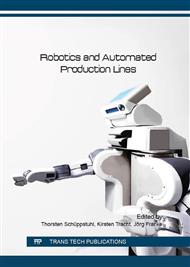[1]
U. Thomas and F. M. Wahl, Planning sensor feedback for assembly skills by using sensor state space graphs, Intelligent Robotics and Applications. Springer, 2012, pp.696-707.
DOI: 10.1007/978-3-642-33515-0_68
Google Scholar
[2]
J. De Schutter, T. De Laet, J. Rutgeerts, W. Decre, R. Smits, E. Aertbelien, K. Claes, and H. Bruyninckx, Constraint-based task specification and estimation for sensor-based robot systems in the presence of geometric uncertainty, The International Journal of Robotics Research, vol. 26, no. 5, pp.433-455, (2007).
DOI: 10.1177/027836490707809107
Google Scholar
[3]
A. van Deursen, P. Klint, J. Visser, Domain-Specific Languages: An Annotated Bibliography. ACM Sigplan Notices, (2000).
DOI: 10.1145/352029.352035
Google Scholar
[4]
S. Harnad, The symbol grounding problem, Physica D: Nonlinear Phenomena, vol. 42, no. 1, pp.335-346, (1990).
DOI: 10.1016/0167-2789(90)90087-6
Google Scholar
[5]
P. Vogt, The physical symbol grounding problem, Cognitive Systems Research, vol. 3, no. 3, pp.429-457, (2002).
DOI: 10.1016/s1389-0417(02)00051-7
Google Scholar
[6]
A. Cangelosi, Grounding language in action and perception: From cognitive agents to humanoid robots, Physics of life reviews, vol. 7, no. 2, pp.139-151, (2010).
DOI: 10.1016/j.plrev.2010.02.001
Google Scholar
[7]
S. Coradeschi, A. Lout, and B. Wrede, A short review of symbol grounding in robotic and intelligent systems, KI-Künstliche Intelligenz, vol. 27, no. 2, pp.129-136, (2013).
DOI: 10.1007/s13218-013-0247-2
Google Scholar
[8]
Y. K. Hwang and N. Ahuja, Gross motion planning - a survey, ACM Computing Surveys (CSUR), vol. 24, no. 3, pp.219-291, (1992).
DOI: 10.1145/136035.136037
Google Scholar
[9]
M. Spangenberg and D. Henrich, Grounding of actions based on verbalized physical effects and manipulation primitives, IEEE/RSJ International Conference on Intelligent Robots and Systems (IROS), (2015).
DOI: 10.1109/iros.2015.7353470
Google Scholar
[10]
A. Nordmann, N. Hochgeschwender, and S. Wrede, A survey on domain-specific languages in robotics, in Simulation, Modeling, and Programming for Autonomous Robots. Springer, pp.195-206, (2014).
DOI: 10.1007/978-3-319-11900-7_17
Google Scholar
[11]
R. Peter Bonasso, R. James Firby, E. Gat, D. Kortenkamp, D. P. Miller, and M. G. Slack, Experiences with an architecture for intelligent, reactive agents, Journal of Experimental & Theoretical Artificial Intelligence, vol. 9, no. 2-3, p.237–256, (1997).
DOI: 10.1080/095281397147103
Google Scholar
[12]
B. Finkemeyer, T. Kroeger, and F.M. Wahl, The adaptive selection matrix – a key component for sensor-based control of robotic manipulators, in IEEE International Conference on Robotics and Automation (ICRA), pp.3855-3862, (2010).
DOI: 10.1109/robot.2010.5509419
Google Scholar
[13]
M. Spangenberg and D. Henrich, Towards an intuitive interface for instructing robots handling tasks based on verbalized physical effects, in RO-MAN: The 23rd International Symposium on Robot and Human Interactive Communication, pp.79-84, (2014).
DOI: 10.1109/roman.2014.6926234
Google Scholar
[14]
International Organization of Standardization, ISO Standards Handbook: Quantities and Units, (1993).
Google Scholar
[15]
J. Awrejcewicz, Classical Mechanics: Kinematics and Statics, Advances in Mechanics and Mathematics, Springer, (2012).
Google Scholar
[16]
G. Pahl, W. Beitz, J. Feldhusen, K. Grote, Engineering Design: A Systematic Approach, Springer, (2007).
Google Scholar
[17]
T. Buchmann, J. Baumgartl, D. Henrich, and B. Westfechtel, Towards a domain-specific language for pick-and-place applications, The Fourth International Workshop on Domain-Specific Languages and Models for Robotic Systems (DSLRob), (2013).
Google Scholar


